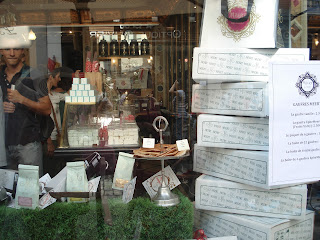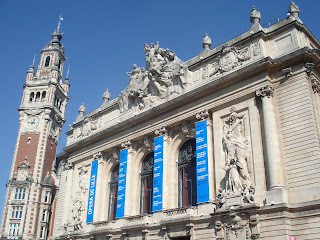An old gentleman and his wife were taking a walk, taking in the sights of Granada when they saw an blind beggar. Moved by this sight, the man turned to his wife and said "Give him alms, my wife, for there is no pain in life greater than to be a blind man in Granada."--Francisco de Icaza
How to begin describing the wonders that you find within this complex of fortress and palace on top of the hill called La Sabika? I am afraid my words will not be enough nor my pictures sufficient to convey the beauty, the delicacy and magnificence but I would like to try...

Before one even gets to see the Palacio Nazaries, the path wends along the the gorgeous Generalife gardens and you get glimpses of the city far below framed against the backdrop of the Sierra Nevada mountains. But finally through this red stone gate, the visit to the Palace begins.
And its plain exterior belies the wonders that are inside. Inside, every facade us covered with beautiful glazed tiles and ornate carved wood.
 |
| Patio de los Arranyanes |
Every room is richly decorated and Islamic artists spared no efforts to turn everything into a feast for the eyes. Its hard to believe that the Alhambra was originally built as a fortress in the 9th century. In the 13th and 14th centuries when Granada was the last bastion of Islamic might in the Iberian peninsula, the emirs converted the fortress into a palace complex. They wanted not only a strong place from which to rule but also a palace that would display the very best of their arts.
Its hard to walk through these rooms and not be transported. Gazing out of the filigreed windows and taking in the highly ornamented walls, I can well imagine the rulers of old taking their leisure here or better yet, ruling their empire.
Everywhere in the Alhambra you see the mingling of art and religion. The two are so closely intertwined as to be inseparable. In the Salon de Comares, the room's domed ceiling contains more than 8000 pieces of cedar in a pattern of stars that represent the seven heavens of Islam. It also represents the complexity of Allahs infinite universe.

Islamic artists filled every wall with religious messages rendered in beautifully carved Arabic script . One phrase "Only Allah is victorious" is repeated 9000 times.
 |
| An example of the scrollwork |
And the palace within the Courtyard of Lions represents the Islamic paradise which is divided into found parts by rivers.
 |
| Palacio de los Leones |
 |
| A glimpse of the ceiling |
These master artisans also filled the Alhambra with water. This precious element can be found in the different pools of the many patios of the palace. In the searing heat of the Andalucian sun, its the perfect way to refresh oneself.


























